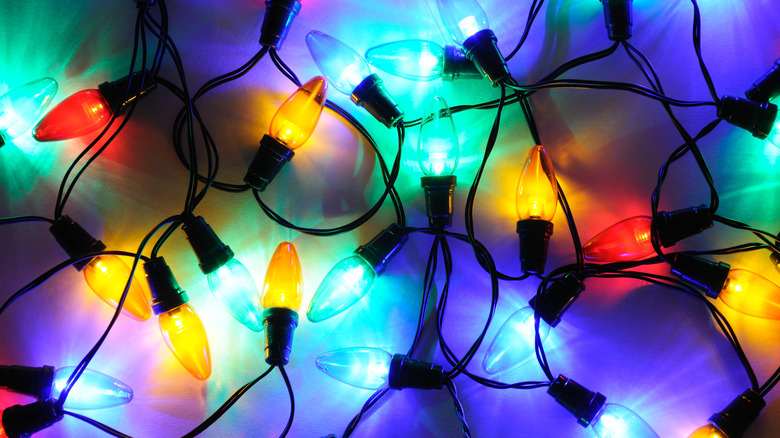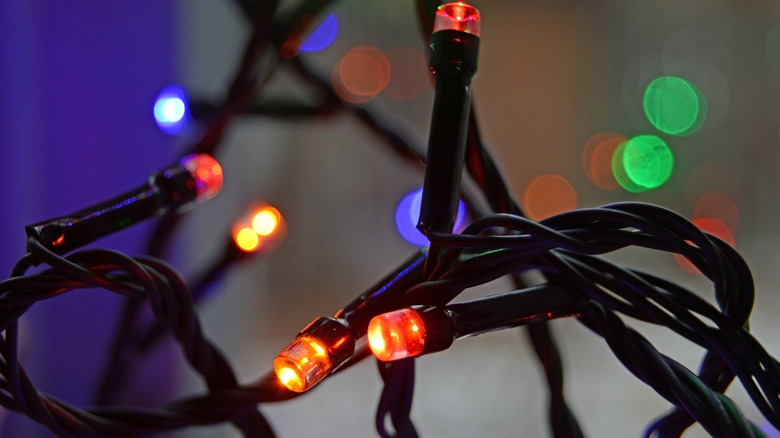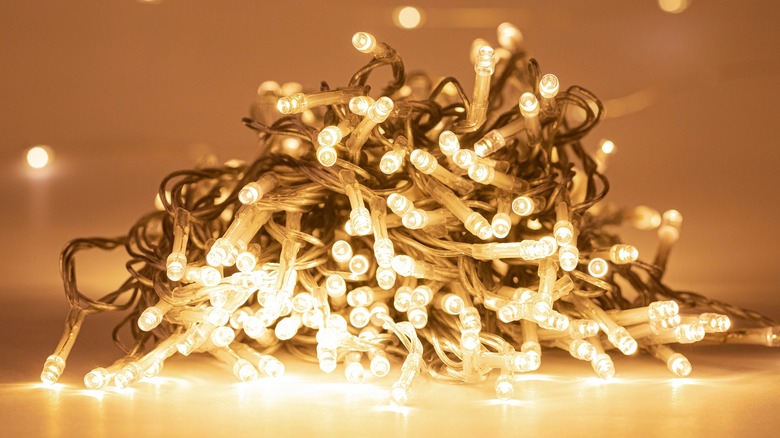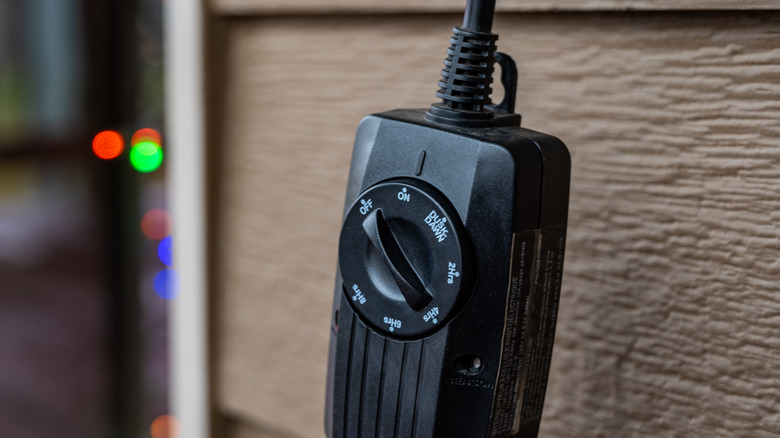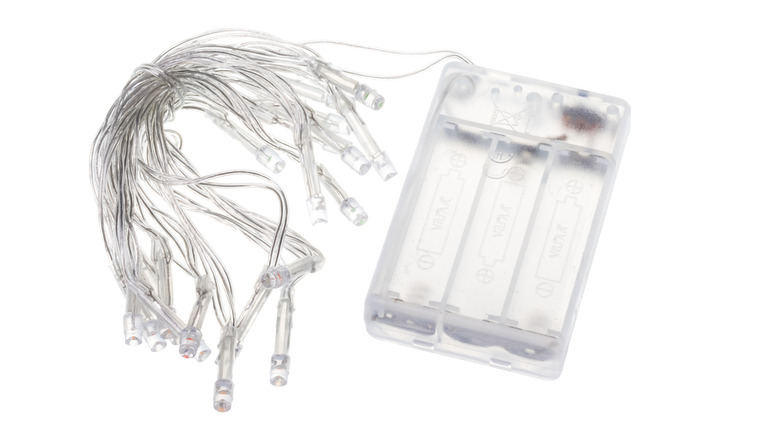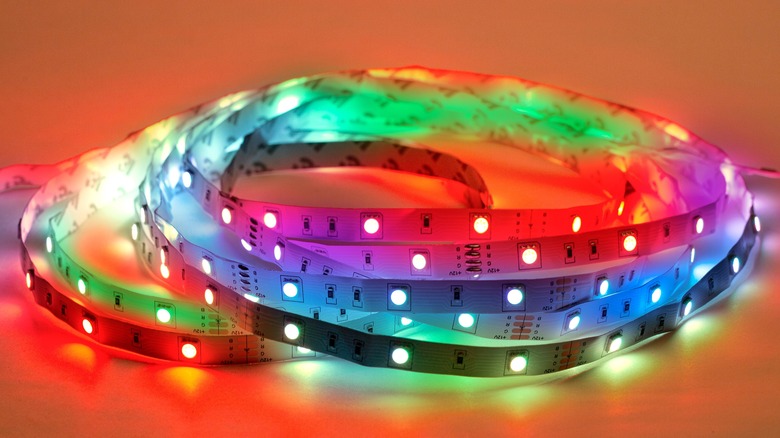How To Keep Your Holiday Lighting As Sustainable As Possible
It's the time of year when people around the world are celebrating some sort of special, festive day. Whether it be Christmas, Hanukkah, Kwanzaa, Yule, or the Winter solstice, December is a month full of warmth, happiness, togetherness, nostalgia, and well wishes for the new year soon to be ushered in. It's officially the season of lights.
One of the best things about the holiday season is the lighting. It doesn't matter if it's a solo string attached to the eves of a house, or a full-on performance spectacular, complete with lights and music synced together, via Country Living, there's never sadness when holiday lights are present. Mulling over the negative impact this particular holiday season has on our planet is the last thing you want to think about when you're enjoying the spectacle of lights, but it's important to be mindful. Overconsumption, excessive waste, and extravagant energy use play a prominent role in this otherwise joyous holiday, writes The Face. But it doesn't have to be that way. Everyone can do their part to make the holidays a more eco-friendly time of the year. It's easy to take small, practical steps to ensure you're doing your part to be as eco-smart as possible. That's why you tackle the small things first, like your holiday lights. If you're unsure how to make your light show more sustainable, never fear. The following tips should help you with that.
Move to LED
If you haven't yet made the switch to LED lights, it's time to join the 21st century. According to the United States Department of Energy, regular incandescent bulbs are pretty much energy suckers, whereas their LED counterparts use an astounding 90% less. On top of that, they also last up to 25 times longer than their old-school incandescent relatives. Less energy used means more money for you to pocket instead of feeding it into your monthly electricity bill. LEDs also don't get hot, so you won't have to worry about the possibility of starting a fire.
LED lights are also super durable and actually do well in climates where the temperatures can dip below freezing. On the other hand, incandescent bulbs don't like cold weather because low temperatures can cause the filament inside to become brittle and break. That just means you'll have to spend more money on lights. Plus, LEDs are brighter and come in a variety of different colors, shapes, and sizes.
Go solar
By far, the most eco-friendly holiday light option on this list is going the solar-powered route. Green Coast notes that solar lights use zero energy and don't produce any methane or CO2 gasses. You're not going to have to worry about any added costs to your monthly utility bill, either, because these lights don't plug into anything. Solar-powered lights are easy to install and also come in more than just a handful of fun shapes besides the standard bulb shape.
Overall, high-quality solar-powered lights are also built to be more energy efficient, meaning they hold up well in extreme temperatures because they don't have the filament inside that incandescent lightbulbs contain. Therefore, they also have a longer lifespan than their plug-in or incandescent counterparts. The only hitch, according to Energy Trend, is that solar power lights rely on the sun to power up. So if you're living in a place with limited light, or if constant cloud cover is a big issue, solar lights might not be the best option for you.
Use a timer
One bummer about holiday lights is that you have to remember to turn them off. Even if everyone in your neighborhood loves festive and sustainable holiday décor, it's a completely different story when your bright LEDs are acting like a 24/7 holiday homing beacon for old Saint Nick himself.
That's why light timers were invented, and there are quite a few different kinds to choose from (though they all work similarly). Light timers act as a middleman between your holiday lights and the outlet and can be programmed to turn on and off at specific times of the day or night, per Green Living Guide. You can also set them to shut off after a certain number of hours. If you really want to get fancy, there are light timers that connect via Bluetooth and can be controlled via an app from your phone or tablet. There are also holiday lights that already have built-in Bluetooth controls, eliminating the need for a separate Bluetooth timer. Isn't technology great?
Battery-powered lights
Battery-powered lights are also relatively wallet-friendly, and your utility bill won't be impacted by their use ... for the most part. Batteries cost money and having to continually purchase them to keep your festive lighting up and running can begin to cost a pretty penny. That's why investing in good quality rechargeable batteries is a financially-savvy and eco-friendly choice. You can expect rechargeable batteries to have a lifespan from two to five years, as noted by Batteries Plus.
Some battery-operated lights even have Bluetooth connectivity, which means you can control them with your phone or tablet. There are also other types of battery-powered lights that use remote controls, and there are even holiday lights that use a combination of the two. Once your batteries have no more life in them, Citizen Sustainable notes that, luckily, both rechargeable and your standard alkaline batteries can be recycled. However, if, for some reason, your municipality does not accept batteries as part of their recycling program, don't throw them in the trash. Batteries are considered to be a type of hazardous waste and should be taken to a special facility for proper disposal.
Invest in permanent holiday lights
While this might not be the choice for everyone, having permanent holiday lights installed on your property is not only economically smart, but it's also a good move for spaceship earth. According to Smithsonian Magazine, over 150 million boxes of holiday string lights are purchased annually in the United States. In the past, it was customary to find and replace the broken bulb in a strand, but nowadays, because lights are so inexpensive (and no one has time for replacing one or two bulbs), string lights usually end up in the trash or recycling. Neither of these options is the correct one, either, per Green Citizen. This is because lights contain materials that can be hazardous to the environment (but some of these components are also recyclable). While holiday lights themselves don't actually break down or produce any hazardous emissions, they can contribute to the overall amount of nasty stuff in landfills, which ultimately increases the amount of methane produced and released into the atmosphere. There are special recycling programs geared specifically towards holiday light recycling, per Christmas Light Source.
Investing in permanent lights keeps discarded décor out of landfills. They're also made with more durable and energy-efficient materials, which helps minimize your overall carbon footprint, per Go Bright Lights. Plus, you don't have to take them down and put them up every year, and some companies offer lights that you can tailor for different holidays.
